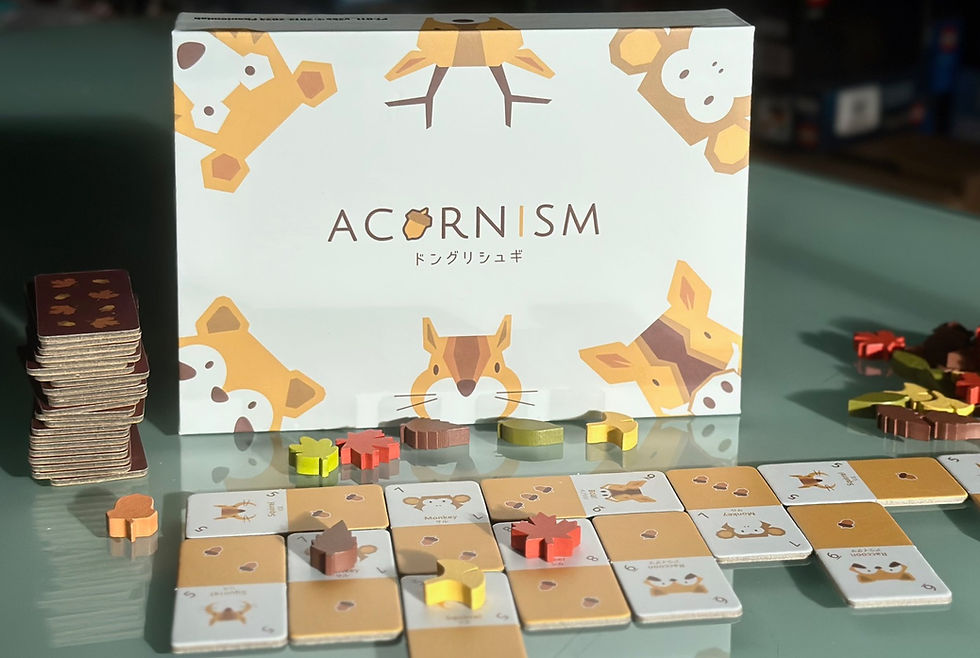Peanut Club
- Board's Eye View

- Feb 21, 2023
- 3 min read
Designed by Henri Kermarrec, with art by Kevin De Castro and Gray Shuko, Peanut Club is a set collection game where players are bidding in a succession of auctions for whimsical icon cards that will score them points at the end of the game for every pair of matching coloured icons. The game is published by Lumberjacks Studio as part of their series of easy-to-teach and quick-to-play 'coffee break' games. It is distributed in the UK by Hachette Board Games.

If there was just one currency, Peanut Club would be a very simple indeed. With just a finite amount of money to spend on successful bids, the 3-6 players would all just be making their own judgement calls on which cards to compete heavily for and which to shrug off and leave for others to buy. Your choice would be dictated by the colour icons on the cards and your prospects of making matching pairs that will score at the end of the game. Your bidding would also be influenced by the fact that 'luxury' and 'antique' items (ie: black and white icons) all score an extra point and each player has a secret collector card that gives them an extra point for all icons of a particular colour.
As you'll have guessed tho', there is more to Peanut Club. There is more than one currency... You can bid in millions of dollars, camels or peanuts. The currencies have no equivalence. They are ranked in value and any bid in a higher ranked currency will beat a bid of a larger amount in the lower currency. So, for example, if the game starts off with the Million Dollars at the bottom, Camels in the middle, and Peanuts on top, then a single camel will be worth more than any number of Millions and a single Peanut will be worth more than any number of Camels.
At the start of the game, players draw a pair of currency cards from the shuffled deck and you each keep drawing pairs of cards until your draw reaches or exceeds a total value of at least 35 (30 in a six-player game). Of course, you're likely to end up with a mix of each of the three different currencies and with cards of various values from 1-5. Players also have five tokens that they can play at any time to skew the auctions. These are flipped when used but they get flipped back when the 'double arrow' card appears in the auction pile. The tokens are especially powerful and you have a judgement call to make about when best to play them. Hold onto them too long while others are profitably playing theirs and you could find the 'double arrow' card comes up refreshing other players' tokens so that they get two uses out of them and you end up getting just the one.
The Crash token can be used to alter a currency's relative position in the market - for example, moving the bottom ranked currency to the top. The Niet token takes a currency out of play for the current auction. A la Carte makes every card in the auction worth just 1 - so if you bid '6 Camels a la carte', you're bidding six Camel cards regardless of the value on each of the cards. Convert lets you pay for a successful bid using cards of any currency. Abracadabra doubles the value of one of the cards you use to pay.
Bidding is anyway a free-for-all: you call out the bids when you want to make them - as in a real auction - there are no 'turns'. The tokens tho' make the bidding lively to the point of chaotic - just right for a party game. Bidding almost always escalates from the lowest to highest value currency unless and until you reckon other players may be starting to run low on the top currency. Tokens tho' manipulate the auctions, and where, for example, a currency is eliminated (Niet) or reordered (Crash), the bidding restarts from zero...
Peanut Club is at its chaotic best with six players where it feels much more like a party game than a more conventional auction game.
#PeanutClub #LumberjacksStudio #auctiongame #bidding #setcollection #cardgame #partygame #HachetteBoardGames #Peanuts #Camels #MillionDollars #coffeebreakgame




